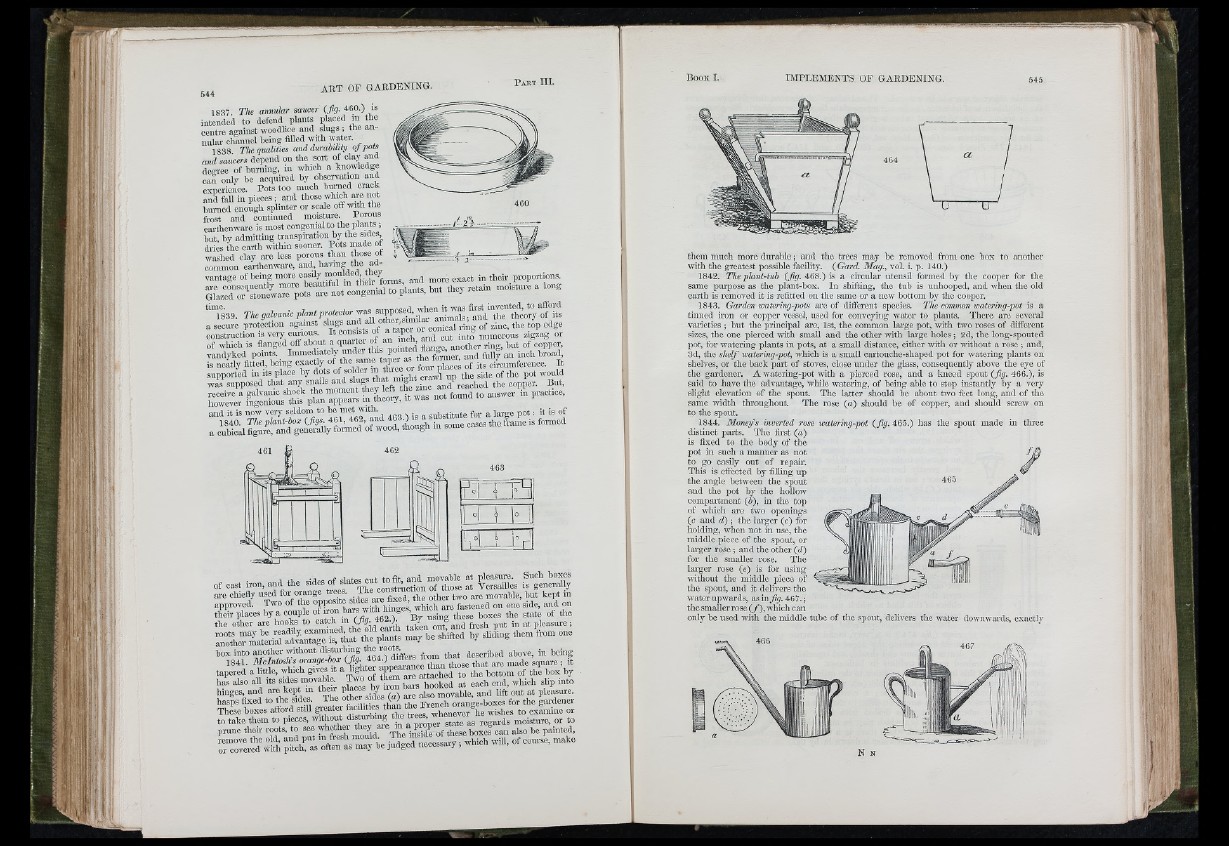
AKT o f GABDENING.
644
1837. The annular saucer (fig. 460.) is
intendea to defoiid plants placed m the
centre against woodlice and slu g s; the annular
channel being filled with water.
1838. The qualities and durability o f pots
and saucers depend on the sort of clay and
desrree of burning, in which a knowledge
can only be acquired hy observation and
experience. Pots too much bm-ned crack
and fall in pieces ; and those which are not
burned enough splinter or scale off with the
frost and continued moisture. Porous
earthenware is most congenial to the plants ;
but, by admitting transpiration by the sides,
dries tho earth within sooner. Pots made of
washed d a y are less porous than those ot
common earthenware,
vantage of being more timfr foms, and more exact in tbeir proportions.
S L M S M M L a r ^ o f e M e n o tL o n g en ia lto p l^ they retain moisture a long
a secure protection against of a ttaper or conical ring of zinc, tho top edge
construction is very onrious. » „ j t jnto numerous zigzag or
of which is flanged off about a q™rtci ^ ring, bnt of copper,
vandyked points.^ as the former, and fully an inch broad,
is neatly fitted, being or four places of its circumference. It
supported in Its place by dots , crand up the side o fth e pot would
wL*^supposed that any snails " ? C f e t ? h “ M ^ “ PP™
i i o t ; ? &gIn7 s1 M p M 7 poars in Leoiy, it was not found to answer in practice,
and it is now very seldoni to ? , ^53 i substitute for a large p o t ; it is of
a
M i d
of cast iron, and the ^ '^ s of s la te ^ c u tjo at .®
are chiefly used for orange i • -fixed the other two are movable, but kept in
approved. Two of the opposite fastened on one side, and on t h d r places b y a coup e o t iron bars with t o
the other are hooks to catch W « 20- “ ^nd fresh put in at plcasm-e;
r t L L M M 7 aM a l” t d the plants may he shifted by sliding them from one
box into another ‘ 454 itif f e r s from that described above, in being
1841. M t a “ i p e S ^ than those that are made square ; it
tapered a little, wluch gives it a hg < PP j^tjuched to the bottom of the box by
M » o l » h »
“ e iM w h h MohMLftOT a s ? ? l e judged necessary ; which will, of course, make
545
them much more dm-able; and the trees may be removed from one box to another
Avith the greatest possible facility. (Gard. Mag., vol. i. p. 140.)
1842. Theplant-tub (fig. 468.) is a circular utensil fbi-mcd by the cooper for the
same pm-pose as the plant-box. In shifting, the tub is unhooped, and Avhen the old
earth is removed it is refitted on the same or a ncAv bottom by the cooper.
1843. Garden watering-pots are of different species. The common watering-pot is a
tinned iron or copper vessel, used for conveying Avater to plants. There are several
varieties ; but the principal are, 1st, the common lai-ge pot, with tAvo roses of different
sizes, the one pierced Avith small and the other with large holes; 2d, the long-spouted
pot, for Avatering plants in pots, at a small distance, eitlicr Avith or without a ro s e ; aud,
3d, the shelf watering-pot, Avhich is a small cartouche-shaped pot for Avatering plants on
shelves, or the back part of stoves, close under the glass, consequently above the eye of
the gardener. A watering-pot with a pierced rose, and a kneed spout (fig. 466.), is
said to have the advantage, while Avatering, of being able to stop instantly by a vciy
slight elevation of the spout. The latter should be about tAvo feet long, and of the
same width throughout. The rose (a ) should be of copper, and should screw on
to the spout.
1844. Money’s inverted rose watering-pot (fig. 465.) has the spout made in thi-ee
distinct parts. The first (a )
is fixed to the body of the
pot iu such a manner as not
to go easily out of repair.
This is eflected by filling up
the angle betAveen the spoilt
aud the pot hy the hollow
compartment (b), in the top
of which ai-e tAvo openings
(c and d) ; the larger (c) for
holding, Avhcn not in use, the
middle piece of the spout, or
larger rose ; and the other (d)
for the smaller rose. The
lai-ger rose (e) is for using
Avithout the middle piece of
the spout, and it delivers the
water upAvards, as in fig. 467.;
the smaller rose ( / ) , Avhich can
only he used with the middle tube of the spout, delivers the water doAvnwards, exactly
N N
I
‘
i